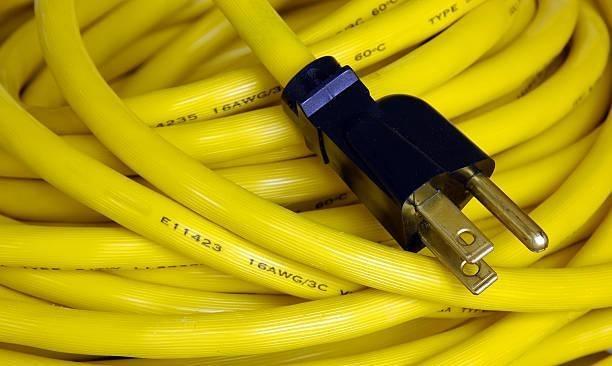When visiting a friend or a relative, one common thing you observe is that there’s always more than one electric appliance. Most common appliances like the refrigerator are meant for indoor use. However, devices like lawnmowers are meant for outdoor use.
What’s more, different types of cords are meant for indoor and outdoor appliances. Therefore, there’s a need to know when to use an indoor or outdoor power extension cord.
You are watching: The Best Ways to Determine If It Is an Indoor or Outdoor Power Cord
Read on to learn more about the differences between an indoor and outdoor power cord and the safety measures to take while handling the extension cords.
How Do Indoor and Outdoor Extension Cords Differ?
If you are wondering how you can differentiate outdoor vs indoor extension cords, you have come to the right place. There are many notable differences between indoor and outdoor extension cords that distinguish them from one another.
One significant difference is the insulation. Extension cords for outdoor use have protective insulation, while indoor extension cords do not. The outdoor cables have more insulation to protect them from harsh weather conditions.
Secondly, outdoor power cords have the letter “W” designated on them, meaning that they can withstand weather conditions and are waterproof. Therefore, if you buy an outdoor extension cord, you should look for one with a heavy-duty appearance and the letter “W” on it.
Another way to distinguish whether a cord is meant for indoor or outdoor use is by checking the cord gauge. The gauge of an extension cord refers to the size of conducting wires on the interior. Thus, most outdoor cords can reach up to 150 feet, while indoor cables can go up to 25 feet.
Read more : Stain vs. Paint: The Pros and Cons of Each Finish
On top of that, outdoor cords can conduct more current as they have a larger conducting wire than indoor cords.
Finally, you can tell whether a cord is for outdoor or indoor use by its plug type. Outdoor extension cords have three prongs, while indoor extension cords have two prongs. The third prong in outdoor cords is because it acts as a grounding wire, reducing the risk of electric shocks or fire.
Thus, you must ensure that you have a socket with a ground slot before purchasing that extension cord.

How To Protect Extension Cords from Weather Conditions?
Even though outdoor extension cords are designed to withstand various weather conditions, such as sun damage and temperature flux, you must take care of them.
One way you can do this is by ensuring that all outlets you plan to use for outdoor cords have a ground fault circuit interrupter (GFCI) built on that outlet.
A GFCI breaks the circuit whenever it detects an irregular electricity flow. Intermittent electricity flow is caused by certain factors, such as when a wire passes through a human or water.
Hence, a GFCI is vital during the rainy or snowy season, as the outdoor cords will likely pass through water. Therefore, they help minimize the cases of electric shock, which can be pretty harmful to humans.
On the other hand, if you do not have a GFCI, you can purchase a GFCI adapter to place at the end of the extension cord. Thus, the cable should always be plugged into the GFCI adapter, which is then directly plugged into the power outlet.

Tips for Safe Use of Outdoor Extension Cords
Read more : Rabbits in Winter: How to Keep Your Rabbit Warm and Prevent Hypothermia
The next thing after purchasing your extension cord for outdoor use and installing a GFCI adapter or a GFCI is to ensure that people and pets are safe from getting electrocuted. Below are some tips to keep your outdoor use extension cords safe.
1. Inspect cords before use
It is crucial to inspect cords before using them. Some things you should check while inspecting outdoor extension cords include; whether it is the correct full length, whether it has cracked or exposed wires, and if it has both ends attached securely.
2. Avoid overloading cords
Another tip for outdoor power maintenance is to ensure you don’t overload cords by attaching too many appliances. Overloading can cause extension cords to overheat, which may lead to a fire breakout.
3. Use brightly colored extension cords
Brightly colored extension cords help you locate them quickly. Most cables are orange extension cords waterproof as it helps make them more visible. This helps prevent people and pets from tripping and makes finding them more accessible.
4. Protect outdoor extension cords
Most outdoor extension cords are waterproof since they have protective insulation. However, there still is a need to protect them. You can safely do this using an outdoor power protector to protect the cords from surges. It is also crucial to avoid any spots where the extension cord will be exposed to snow or rainwater.

Wrapping Up
When you purchase an extension cord, it is essential that you know how to tell if an extension cord is for outdoor use or indoor use. This is because danger might occur if you use indoor cables for outdoor use. This is because danger might occur if you use indoor cables for outdoor use.
Besides, understanding the difference between outdoor and indoor cords will help you know how to care for them.
For example, you can protect the cord from power surges by buying a GFCI adapter and placing it on both sides of the cord.
Source: https://gardencourte.com
Categories: Outdoor

